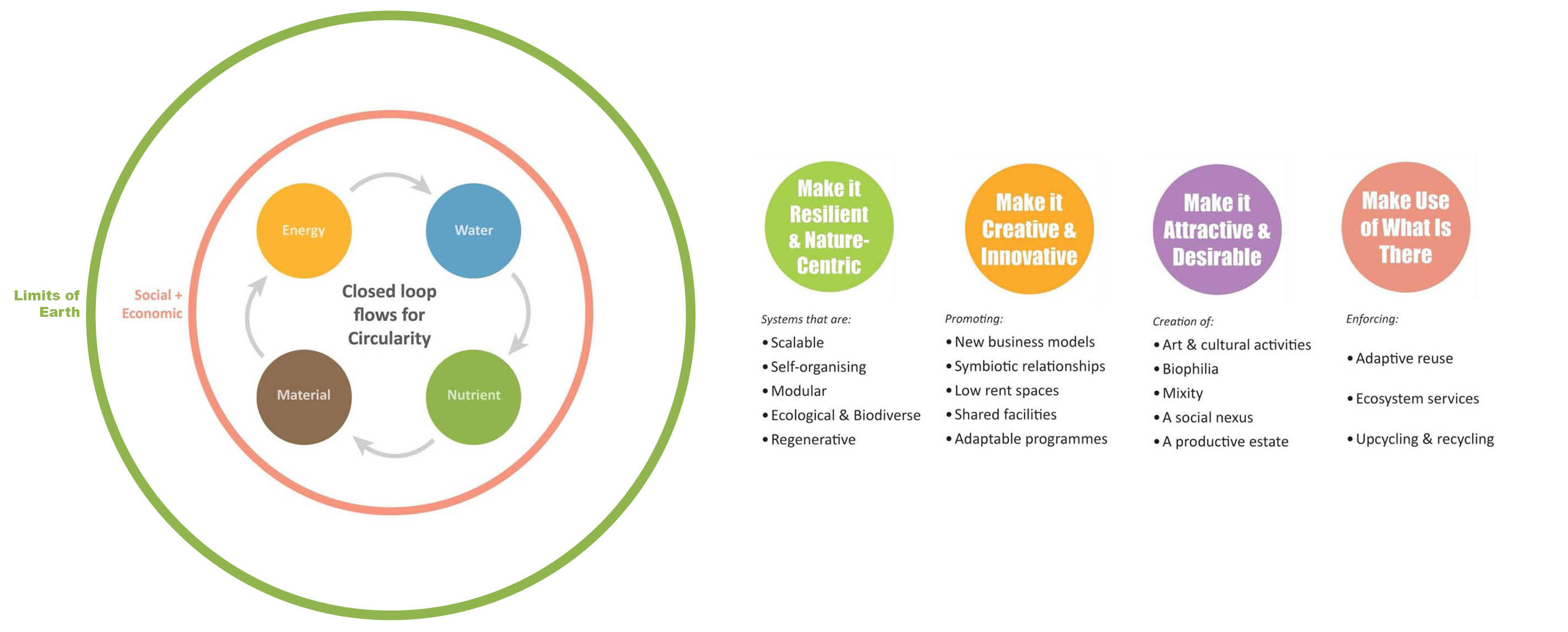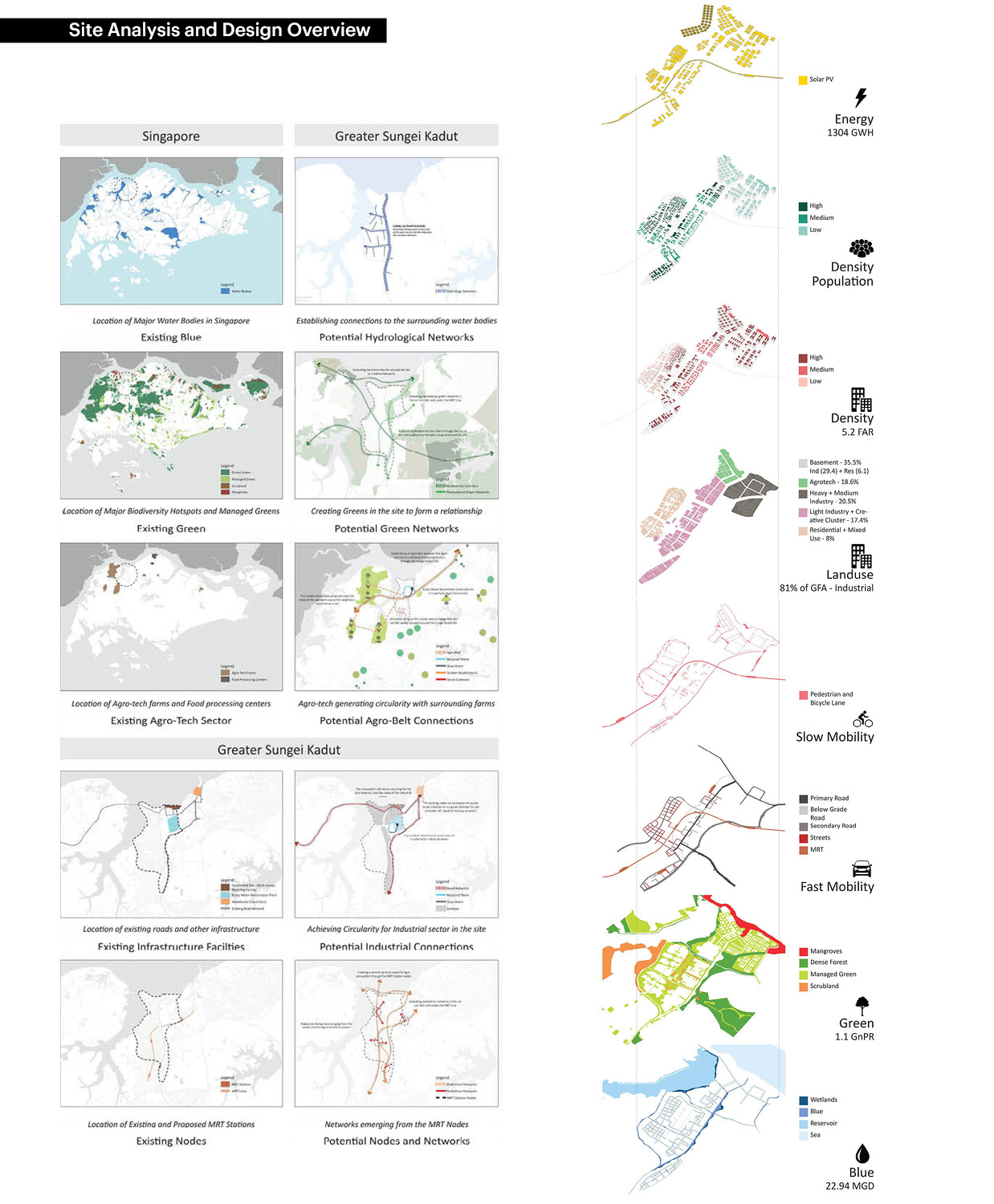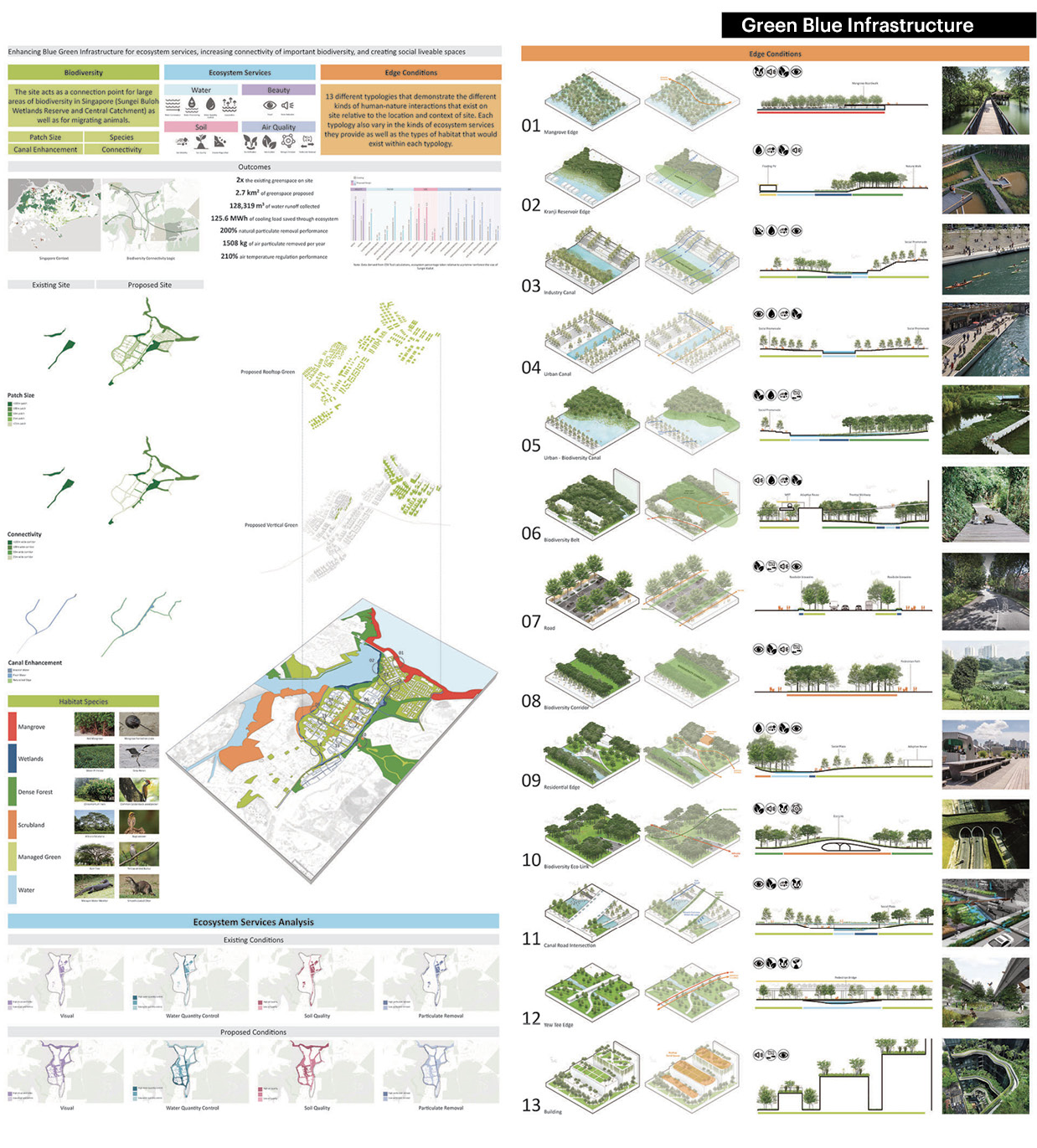Sungei Kadut Masterplan
Sungei Kadut Masterplan
Re-imagining Sungei Kadut as an resilient, intelligent, efficient, and circular industrial hub of Singapore
Christina Brown | Spring 2019 Study Abroad | National University of Singapore, Master of Science in Integrated Sustainable Design Studio
Project Team: Samyuktha Badrinarayanan, Jhanvi Yogesh Sanghvi, Supratim Sengupta, Harsh Vardhan
Advisors: Nirmal Kishnani (NUS), Wong Mun Summ (WOHA), Herbert Dreiseitl (NUS/Dreiseitl Consulting)
Project Team: Samyuktha Badrinarayanan, Jhanvi Yogesh Sanghvi, Supratim Sengupta, Harsh Vardhan
Advisors: Nirmal Kishnani (NUS), Wong Mun Summ (WOHA), Herbert Dreiseitl (NUS/Dreiseitl Consulting)

Sungei Kadut is an industrial estate located on the Northern edge of Singapore that contains a large portion of construcion industry and mangufacturing industry within the country. This masterplan re-imagines how Sungei Kadut can function within an ecological framework that is resilient, intelligent, efficient, and circular.
Through intensive workshops on circular economy, ecology and sustainability, and urban design, a framework understanding of ecological thinking and circular economy was developed for this 6km sqm site.
The project was sponsored by Jurong Town Corporation (JTC), a subgroup of the Ministry of Welfare in Singapore. The final design for this studio was presented to government officials, and exhibited at the Singapore URA.
The design work contributed to a S$650 million masterplan project for the Sungei Kadut industrial estate, and is an on-going collection of work as a part of the graduate studio.
Through intensive workshops on circular economy, ecology and sustainability, and urban design, a framework understanding of ecological thinking and circular economy was developed for this 6km sqm site.
Circular Economy WS:
Ken Webster (Ellen MacArthur Foundation), Sann Carriere (So Now)
Ecology/Sustainability WS:
Chrisna Du Plessis (University of Pretoria), and Anuj Jain (BioSea, Biomimicry Singapore Network)
Urban Design WS:
Serge Salat (Urban Morphology and Complex Systems Institute)
The project was sponsored by Jurong Town Corporation (JTC), a subgroup of the Ministry of Welfare in Singapore. The final design for this studio was presented to government officials, and exhibited at the Singapore URA.
The design work contributed to a S$650 million masterplan project for the Sungei Kadut industrial estate, and is an on-going collection of work as a part of the graduate studio.


Sungei Kadut is an industrial estate on the Northern edge of Singapore. This 6km estate is situated within important blue and green contexts, as well as near several agro-tech centers.
As Singapore continue to focus on improving transportation, living quality, environmental protection, and addressing concerns for food scarcity and food production, these different contexts become increasingly important for the site’s development.
Taking these important contexts in mind, it was necessary to understand the potentials and concerns within the site, and develop strategies for how the different layers could work collectively to create a circular and healthy ecosystem.
From the development, a series of layers are broken down to devleop a new mixed use estate that focus on innovation and technology while integrating the natural systems and exisiting contexts.
As Singapore continue to focus on improving transportation, living quality, environmental protection, and addressing concerns for food scarcity and food production, these different contexts become increasingly important for the site’s development.
Taking these important contexts in mind, it was necessary to understand the potentials and concerns within the site, and develop strategies for how the different layers could work collectively to create a circular and healthy ecosystem.
From the development, a series of layers are broken down to devleop a new mixed use estate that focus on innovation and technology while integrating the natural systems and exisiting contexts.
With the aid of professors Herbert Dreiseitl and Anuj Jain, we developed blue green infrastructure strategy for Sungei Kadut. This breaks down into 3 key sections:
Biodiversity
Working with biologist Anuj Jain, different habitat types and flora/fauna specifies were identified for the site. These were developed based on the exisiting and historical conditions of Sungei Kadut to help rejuvenate the local environment. The patch size, canal quality, species on site, and the connectivity of the green infrastructure were all considered to allow for the preservation of local biodiversity. Given that Singapore is a key biodiversity hotspot, local conservation and strengthening of the ecological connectivity is crucial, and played a large role in the blue green infrastructure development.
Ecosystem Services
Through the use of the ESII tool, the existing site ecosystem and new proposed ecosystem were analyzed for tis ecosystem services. This breaks down into 4 categories - water, beauty, soil, and air quality. Quantitative benefits could be extracted from the tool to understand the impact and benefits that the proposed infrastructure offered, and provided additional information that supported considerations for land use distribution and ecological integration based on desired services.
Edge Conditions
13 edge conditions were developed to highlight the diversity of experiences that would be offered on site. Each condition is located within a different area of the site, and each offers very different experiences to the occupants. The ecosystem services that are related to each edge condition is highlighted, as well as notable programmatic features and a relavant case study example is provided. These conditions showcase key blue green infrastructural details that relates to programmatic functions and regenerative site solutions.
- Biodiversity
- Ecosystem Services
- Edge Conditions
Biodiversity
Working with biologist Anuj Jain, different habitat types and flora/fauna specifies were identified for the site. These were developed based on the exisiting and historical conditions of Sungei Kadut to help rejuvenate the local environment. The patch size, canal quality, species on site, and the connectivity of the green infrastructure were all considered to allow for the preservation of local biodiversity. Given that Singapore is a key biodiversity hotspot, local conservation and strengthening of the ecological connectivity is crucial, and played a large role in the blue green infrastructure development.
Ecosystem Services
Through the use of the ESII tool, the existing site ecosystem and new proposed ecosystem were analyzed for tis ecosystem services. This breaks down into 4 categories - water, beauty, soil, and air quality. Quantitative benefits could be extracted from the tool to understand the impact and benefits that the proposed infrastructure offered, and provided additional information that supported considerations for land use distribution and ecological integration based on desired services.
Edge Conditions
13 edge conditions were developed to highlight the diversity of experiences that would be offered on site. Each condition is located within a different area of the site, and each offers very different experiences to the occupants. The ecosystem services that are related to each edge condition is highlighted, as well as notable programmatic features and a relavant case study example is provided. These conditions showcase key blue green infrastructural details that relates to programmatic functions and regenerative site solutions.




Project that continues
The work was presented to government officials and key professionals at the end of the study abroad experience, with Supratim and I leading the discussion.
The design were exhibited at the Singapore URA later, which was made public and presented to additional government officials.
The official S$650 million project for Sungei Kadut was announced soon after.
The design were exhibited at the Singapore URA later, which was made public and presented to additional government officials.
The official S$650 million project for Sungei Kadut was announced soon after.
